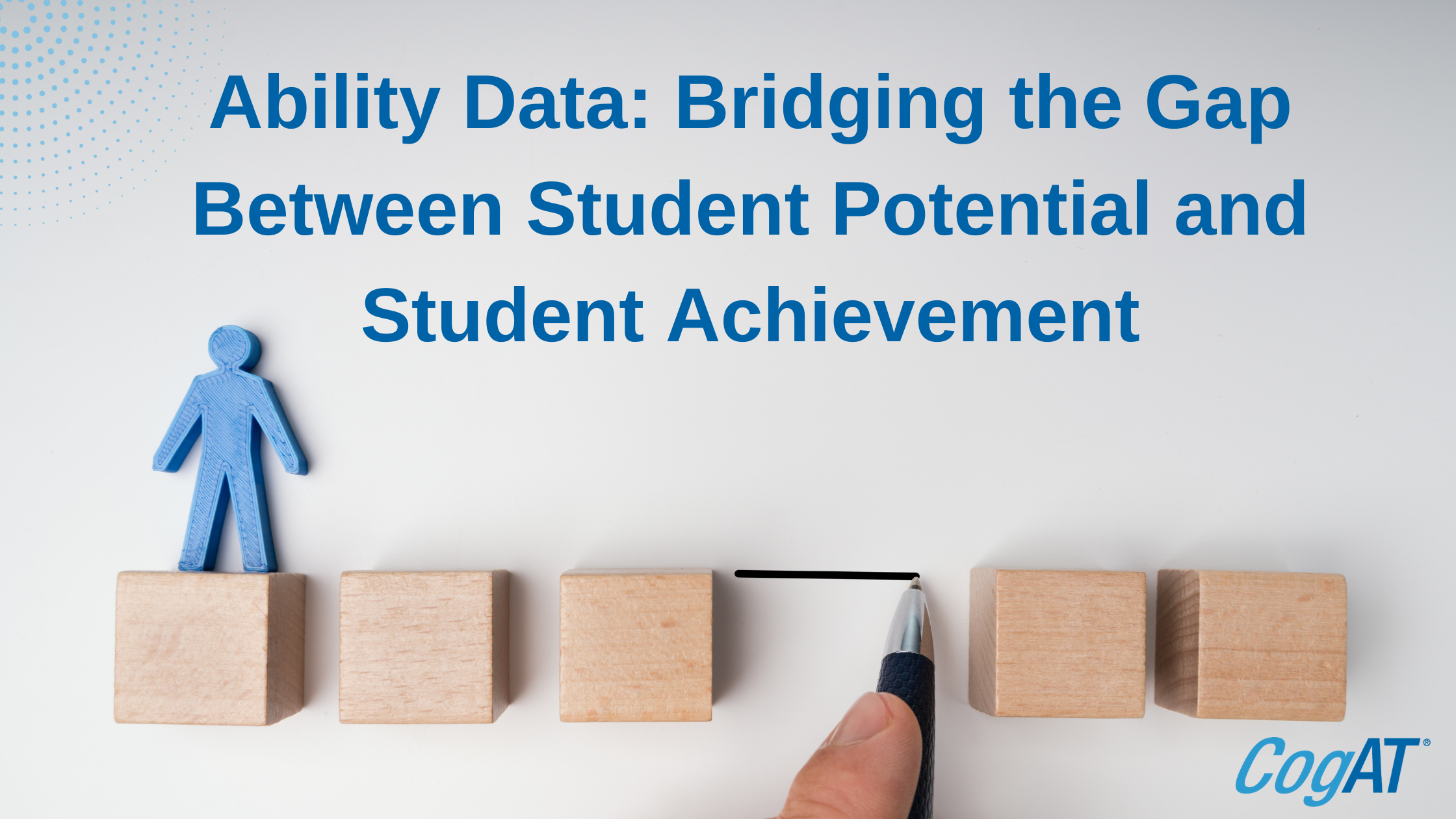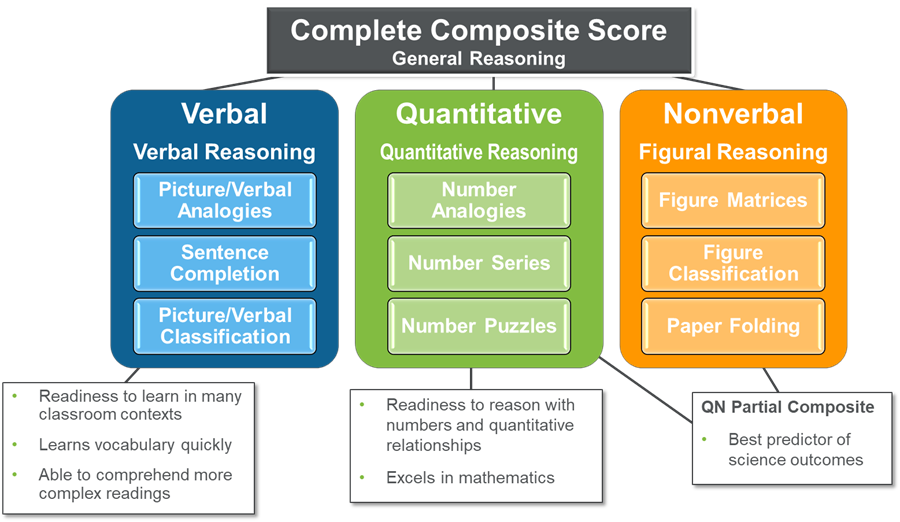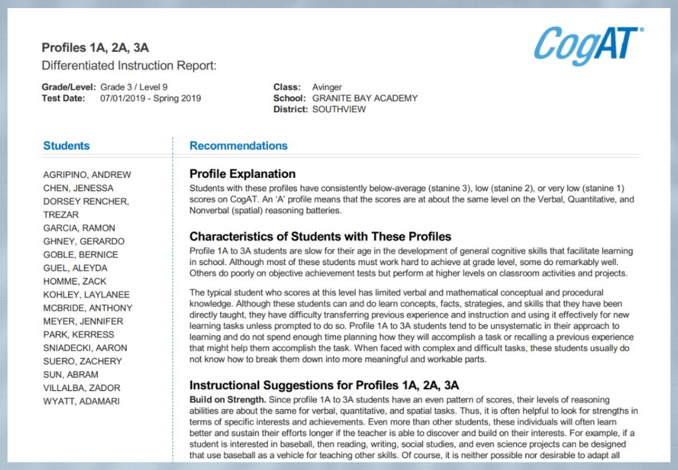Ability Data: Bridging the Gap Between Student Potential & Achievement

Ability Data: Bridging the Gap Between Student Potential and Student Achievement
Chances are, you already have an idea of what your students have learned. You’ve got benchmark tests, chapter quizzes, portfolios of student work – any number of data points that demonstrate what your students have achieved. But do you know how your students learn? Between COVID disruptions, growing opportunity gaps, and constantly shifting standards, individualized differentiation is more important than ever even as teacher bandwidth is at an all-time low. Ability data provides educators a fresh and meaningful way to understand each student’s potential for learning and to easily differentiate instruction based on individual needs.
%20(1040%20%C3%97%20940%20px)%20(1240%20%C3%97%20940%20px)%20(1240%20%C3%97%20500%20px)%20(2).png?width=753&name=Copy%20of%20Copy%20of%20IAAT%20Infographic%20%23%201%20(940%20%C3%97%201000%20px)%20(1040%20%C3%97%20940%20px)%20(1240%20%C3%97%20940%20px)%20(1240%20%C3%97%20500%20px)%20(2).png)
What is ability?
Ability, also called aptitude or student potential for learning, provides insight into students’ readiness to demonstrate creative problem-solving skills and learn in different situations and learning environments. Understanding student potential for learning in combination with the way a student interacts with their educational setting – whether it be guided classroom learning, project-based scenarios, or hybrid or remote situations where students may need to be more independent in their learning – sets the stage to enable student success in the learning environment.
%20(1040%20%C3%97%20940%20px)%20(1240%20%C3%97%20940%20px)%20(1240%20%C3%97%20500%20px)%20(1240%20%C3%97%20375%20px)%20(1).png?width=750&name=Copy%20of%20Copy%20of%20IAAT%20Infographic%20%23%201%20(940%20%C3%97%201000%20px)%20(1040%20%C3%97%20940%20px)%20(1240%20%C3%97%20940%20px)%20(1240%20%C3%97%20500%20px)%20(1240%20%C3%97%20375%20px)%20(1).png)
Ability is influenced by all experiences both in and out of the classroom. Measuring ability looks at problem solving and reasoning processes that, while important for success in school and highly correlated with achievement, are much less dependent on formal schooling. When students experienced remote and hybrid learning settings due to COVID, there is every reason to believe that students’ capacity for reasoning and problem-solving abilities continued to grow – whether they were in or out of a typical school environment. Think about the student at home with younger siblings and a parent who is an essential worker. The type of reasoning and problem solving this student may have had to use and develop during this time is far less likely to show as academic progress or achievement – but these are still learning opportunities, and this development and maturation should be reflected in the student’s ability or potential for learning.
%20(1040%20%C3%97%20940%20px)%20(1240%20%C3%97%20940%20px)%20(1240%20%C3%97%20500%20px)%20(4).png?width=1240&name=Copy%20of%20Copy%20of%20IAAT%20Infographic%20%23%201%20(940%20%C3%97%201000%20px)%20(1040%20%C3%97%20940%20px)%20(1240%20%C3%97%20940%20px)%20(1240%20%C3%97%20500%20px)%20(4).png)
There is a strong correlation between ability and achievement, but there are always outliers. Even a high ability/high potential student may not have good outcomes in a given situation, such as the highly able student who becomes bored with the program and “checks out.” How can one access that student’s ability and enable their achievement? A variety of strategies can be used to re-engage the student including using interest-based content, accelerated pacing, project-based activities, and opportunities for independent learning. However, the starting point is first knowing that the student has high potential to learn.
Similarly, you may see a student with demonstrated high achievement fall in the normal range across some areas of cognitive reasoning. Typically, these students are great learners – for everything they are specifically taught. Where they may need help is grappling with novel problems, learning independently, and extending their learning to new contexts. Understanding this student’s reasoning profile, such as areas of strength and relative weakness, provides an important key to helping them access and extend their ability to learn. Just think how a student like this can further achieve with new learning strategies.
What ability data tells us
The Cognitive Abilities Test™ (CogAT®) offers content to measure general and abstract inductive and deductive problem solving across three areas – Verbal, Quantitative, and Nonverbal (figural) reasoning. These are usually referred to in the scores and reports by their initials, V, Q, and N.

The CogAT composite (VQN) reflects general reasoning ability, a powerful predictor of academic success. Each battery score is reliable and valid individually and reflects students’ ability in that domain which allows us to predict success in specific areas of learning more effectively.
-
-
- For example, strength in Verbal Reasoning indicates readiness to learn language and vocabulary quickly and to comprehend more complex reading material.
- A strength in Quantitative Reasoning is aligned with success in math.
- The QN partial composite is a great indicator of science outcomes.
-

More than Gifted identification
The CogAT is the #1 gifted identification tool but its insights were actually designed to differentiate instruction – not only for gifted students, but for every student . Each student that completes CogAT receives an Ability Profile™ – one of the most powerful data points that CogAT provides. It offers a targeted summary of a student’s overall cognitive ability, areas of strength and relative weakness, and links directly to detailed information about that student’s potential for learning and suggestions for instruction.
Ability Profiles can be individually entered and explored at cogat.com, or viewed in a list with similarly-able students conveniently grouped via CogAT’s Differentiated Instruction Report, available in the CogAT Dashboard. (pictured above)
In short, the insights offered by CogAT about student ability are an important key to fully unlock and access student potential for success and achievement.


.png?width=900&name=Copy%20of%20CogAT%20Resources%20Page%20(4).png)
%20(11).png?width=900&name=NEW%20Addressing%20External%20Influences%20FEBE%20(2240%20%C3%97%201260%20px)%20(11).png)

-1.png)